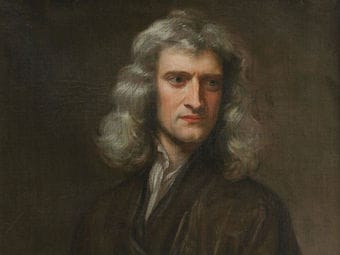An astronomical chart made in 1660 by Andreas Cellarius (1596-1665), inspired by the model of our solar system developed by the Revd Nicolaus Copernicus (1473-1543) in his De Revolutionibus Orbium Coelestium (1543), which recognised at last that the earth and other planets orbit the sun. Johannes Kepler (1571-1630) developed three laws of planetary motion that described these orbits with mathematical precision, but could not account for the complex forces at work. It was Newton’s laws of motion and of universal gravitation, set out in Principia Mathematica (1687), that explained them and, as Stukeley so aptly put it, began to unfold the Universe to our minds.
“Nature and Nature’s Laws lay hid in night;
God said, Let Newton be! — And all was light.”
(Alexander Pope)
“THEREFORE does this apple fall perpendicularly, or toward the centre. If matter thus draws matter, it must be in proportion of its quantity. Therefore the apple draws the earth, as well as the earth draws the apple.”
And thus by degrees, he began to apply this property of gravitation to the motion of the earth, and of the heavenly bodies: to consider their distances, their magnitudes, their periodical revolutions: to find out, that this property, conjointly with a progressive motion impressed on them in the beginning, perfectly solved their circular courses; kept the planets from falling upon one another, or dropping all together into one centre. And thus he unfolded the Universe. This was the birth of those amazing discoveries, whereby he built philosophy on a solid foundation, to the astonishment of all Europe.
Abridged and modernised
Questions for Critics
1. What is the author aiming to achieve in writing this?
2. Note any words, devices or turns of phrase that strike you. How do they help the author communicate his ideas more effectively?
3. What impression does this passage make on you? How might you put that impression into words?
Based on The English Critic (1939) by NL Clay, drawing on The New Criticism: A Lecture Delivered at Columbia University, March 9, 1910, by J. E. Spingarn, Professor of Comparative Literature in Columbia University, USA.
Précis
As Newton thought about this attractive force, he realised that all objects, large and small, must exert it in some degree, and that this would account for the motion of the planets in orbit around the sun. Over time, the speculations begun beside that apple tree led him and fellow scientists to an astonishing number of new discoveries. (58 / 60 words)
As Newton thought about this attractive force, he realised that all objects, large and small, must exert it in some degree, and that this would account for the motion of the planets in orbit around the sun. Over time, the speculations begun beside that apple tree led him and fellow scientists to an astonishing number of new discoveries.
Variations: 1.increase the length of this precis to exactly 65 words. 2.reduce the length of this precis to exactly 55 words. 3.introduce one of the following words into the precis: although, besides, if, just, may, ought, whether, who.
Archive
Word Games
Spinners Find in Think and Speak
For each group of words, compose a sentence that uses all three. You can use any form of the word: for example, cat → cats, go → went, or quick → quickly, though neigh → neighbour is stretching it a bit.
This exercise uses words found in the accompanying passage.
1 Assure. Think. Thus.
2 Center. Do. Revolution.
3 Circular. Distance. Impress.
Variations: 1. include direct and indirect speech 2. include one or more of these words: although, because, despite, either/or, if, unless, until, when, whether, which, who 3. use negatives (not, isn’t, neither/nor, never, nobody etc.)
Confusables Find in Think and Speak
In each group below, you will find words that are similar to one another, but not exactly the same. Compose your own sentences to bring out the similarities and differences between them, whether in meaning, grammar or use.
This exercise uses words found in the accompanying passage.
Homonyms Find in Think and Speak
Each of the words below has more than one possible meaning. Compose your own sentences to show what those different meanings are.
This exercise uses words found in the accompanying passage.
1. Just. 2. Well. 3. Found. 4. Ground. 5. Draw. 6. Circular. 7. Keep.
Add Vowels Find in Think and Speak
Make words by adding vowels to each group of consonants below. You may add as many vowels as you like before, between or after the consonants, but you may not add any consonants or change the order of those you have been given. See if you can beat our target of common words.
bnd (7)
abound. band. bend. bind. bond. boned. bound.
Post Box : Ask Nicholas
Grok : Ask Grok
You are welcome to share your creativity with me, or ask for help with any of the exercises on Clay Lane. Write to me at this address:
See more at Post Box.
If you like what I’m doing here on Clay Lane, from time to time you could buy me a coffee.
Buy Me a Coffee is a crowdfunding website, used by over a million people. It is designed to help content creators like me make a living from their work. ‘Buy Me a Coffee’ prides itself on its security, and there is no need to register.
Related Posts
William Herschel showed that variations in the brightness of the sun were causing climate change, but hardly anyone believed him.
Picture: © Hermann Luyken, Wikimedia Commons. Licence: Public domain. Source.
Posted June 22 2021
Sir Isaac’s secretary has left us an engaging portrait of a kindly genius, the absent-minded professor of our fancy.
Picture: By Sir Godfrey Kneller (1646-1723), via Wikimedia Commons. Licence: Public domain.. Source.
Posted April 13 2021
Edmond Halley will forever be associated with the comet named after him, but his greatest achievement was getting Sir Isaac Newton to publish ‘Principia Mathematica’.
Picture: From Wikimedia Commons.. Source.
Posted March 13 2015
John Goodricke’s observations of Algol won him the Copley Medal while still in his teens, despite his disability.
Picture: © Tom Pennington, Geograph. Licence: CC-BY-SA 2.0.. Source.
Posted March 13 2015






